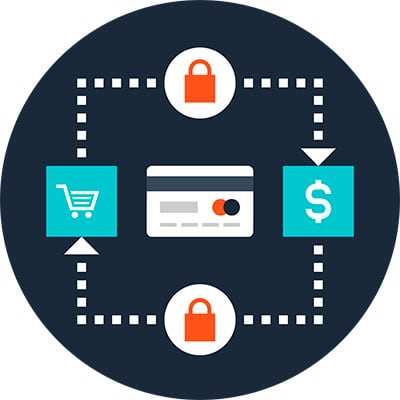When it comes to online shopping, e-commerce sites store customer data that includes credit card information, bank accounts, and personal identifying information.
Without proper security measures in place, these sites are at risk of losing customers’ data and revenue. According to a study conducted by LexisNexis on e-commerce fraud, digital retail stores are more vulnerable to fraudulent transactions as compared to physical retail stores. Furthermore, fraudsters are becoming smarter as technology advances.

E-commerce Security Risks Currently Faced by Online Retailers
Security risks associated with e-commerce can be as a result of human error, an accident or unauthorized access to systems. Online retailers are most likely to face credit card fraud or data errors. Their online stores are also likely to face phishing attacks, distributed denial of service (DDoS) attacks and man-in-the-middle attacks as explained below.
Credit Card Fraud
Credit card fraud is the most common security threat that online retailers face. It occurs when a hacker gains unauthorized access to customers’ personal and payment information. To access this data, the hacker may penetrate the database of an e-commerce site using malicious software programs. At times, a hacker’s intention when stealing customers’ data is to sell it on black markets.
Distributed Denial of Service (DDoS) Attacks
This type of security threat aims at taking down an online retail store by sending overwhelming requests to its servers. The attacks originate from thousands of untraceable IP addresses. When this type of threat hits the servers, they slow down or completely shut down. An e-commerce site can also go offline temporarily when a DDoS attack affects its servers.
Man-in-the-middle Attacks
As hackers are becoming smarter with technology, they are devising ways of listening to the communications made by users of an e-commerce website. Through an approach known as a man-in-the-middle attack, these hackers maliciously trick users into connecting to a public wireless network. They gain access to people’s devices once they are on public wireless networks. Hackers get to see a people’s browsing history, credit card numbers, passwords and usernames if the websites they are visiting lack strong encryptions.
Bad Bots
Bots, either good or bad, are all over the worldwide web. Search engines such as Bing and Google use good bots for indexing search results. On the other hand, there are hackers that use malicious bots for gathering data such as product data, inventories and pricing data. These bots are also capable of accessing the database of an e-commerce site and listing the logins of user accounts.
Malware
In information technology, malware simply refers to malicious software programs. Attackers usually inject web pages or files with these malicious programs to help them in gaining access to online retails stores. Through means such as SQL injection, they can easily insert the malware into a website’s database allowing it to compromise the data stored in the database.
Phishing Scams
E-commerce sites are also prone to phishing scams sent by known or unknown people in form of emails. These scams focus on targeting important user data like credit card numbers and login credentials. An attacker may use a scheme known as social engineering to lure online shoppers to give out their personal information. When sent in an email to an online shopper, a phishing scam may contain a link to a malicious site that resembles an e-commerce site.

Best Practices to Curb the Security Issues in E-commerce
Fraud costs online retailers billions of dollars yearly. To solve the security issues in e-commerce, merchants and payment companies should collaboratively come up with effective solutions. Though these security issues are becoming intense with time, there are solutions that online retailers can implement without affecting the user experience of their sites. In other words, they can adopt the following solutions without impacting the customer experience.
Choose a PCI Compliant Hosting Provider
PCI compliant hosting providers usually have stringent procedures and policies in place for guaranteeing secure payments. They also ensure that online shoppers can conveniently use their debit or credit card to pay for goods or services. Measures that they adopt include risk analysis, extensive monitoring, use of anti-malware software and encryption. Besides relying on a PCI compliant hosting provider, online retailers should also deploy regular PCI updates and scans on their sites to prevent security threats.
Use an Address Verification System (AVS)
One of the safest ways online retailers can facilitate credit card processing is by the use of an Address Verification System (AVS). This system is capable of comparing a customer’s billing address against the information stored on file by a credit card issuer. It can block any suspicious transactions if the information provided doesn’t match with the one stored on the credit card.
Require stronger passwords
The reason why hackers easily gain access to users’ login credentials is that most e-commerce sites fail to ask users to provide stronger passwords. Hackers can utilize algorithms to figure out the passwords easily. A strong password contains a mix of alphabetical letters and numbers.
Use SSL Certificates
It is mandatory for e-commerce websites to have SSL certificates like Comodo SSL Certificate, RapidSSL, GeoTrust SSL Certificate, Thawte SSL, DigiCert SSL Certificate, etc.. for facilitating secure user connections. These certificates are also useful in authenticating the identity of an online retail business and securing users’ checkout data. They also keep customers of online retail stores protected from financial fraud or information loss.
Final Thoughts
For payment providers and online retailers to continue achieving their business goals, they need to join forces and find a working solution to the security threats faced by both. Besides financial consequences, these security threats damage their reputation. With the proper tools in place, they can mitigate the threats.
If you’re interested in more posts about e-commerce and retail, check out our complete report detailing how technology is transforming the both brick-and-mortar and online stores.








